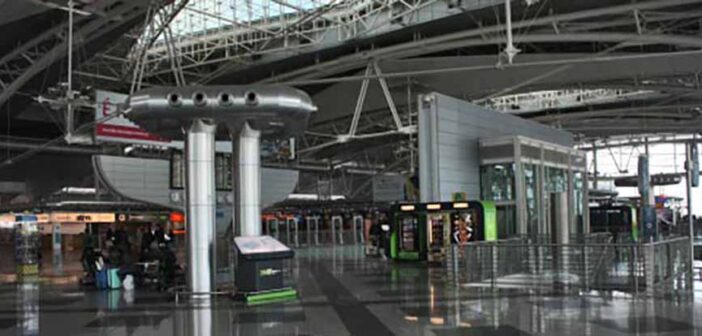Francisco Sل Carneiro Airport, commonly known as Porto Airport, located 11 kilometres northwest of Porto’s city centre, serves as a modern and efficient hub for over 15 million passengers annually. As Portugal’s second-busiest airport, it connects travellers to 110 destinations across 30 countries, with airlines like Ryanair, easyJet, TAP Air Portugal, and Lufthansa operating regular flights. Its well-designed terminal and accessible transport links make it a convenient gateway for exploring Porto’s historic charm or connecting to European and international destinations.
Getting to and from the airport is straightforward. The Violet (E) metro line links the airport to Porto’s city centre in about 25–30 minutes, with departures every 20 minutes from 6:00 AM to 1:00 AM, costing €2.60 plus a €0.50 reusable Andante card. The 601, 602, and 604 bus lines, operated by STCP, connect to areas like Cordoaria and Saint Joمo Hospital for €1.95, with night services available.
Taxis and rideshare options like Uber, found outside arrivals, cost €20–€30 for a 15–20-minute ride to downtown. Drivers can access the airport via the A41 motorway, with five parking lots offering 2,000 spaces, including short-term, long-term, and valet options. A 10-minute free drop-off zone is available, though extended stays incur higher fees.
The airport’s single terminal, spanning three floors, is designed for ease of navigation. The ground floor houses arrivals and baggage claim, while departures and 60 check-in desks are on the third floor. After security, 22 boarding gates and retail areas occupy the second level. A glass-walled departures hall and five skylights create a bright, airy space, though some gate areas can feel warm due to large windows. Clear signage in Portuguese and English aids movement, but peak summer periods can lead to crowded check-in and security areas. Passengers should arrive 90 minutes early for Schengen flights, 120 minutes for non-Schengen, and 180 minutes for intercontinental ones to account for potential queues.
Dining and retail options cater well to travellers. Over 20 eateries, including O Mercado for Portuguese dishes like bacalhau and international chains like Burger King, operate from 5:30 AM to 10:30 PM, with some airside cafés open earlier. The duty-free shop offers Port wine, cosmetics, and electronics, while boutiques like Swarovski and Relay sell fashion, souvenirs, and travel essentials. Prices are reasonable, with water bottles at €1, though dining options dwindle after 10:00 PM, leaving late-night travellers with limited choices.
Facilities enhance the passenger experience with practical amenities. Free Wi-Fi is available via the “_VINCI Airports WiFi” network, though some report connection issues, and charging points are abundant in seating areas. The ANA and CIP lounges, accessible for €37.26 for three hours, offer snacks, drinks, and workspaces, with the CIP lounge suited for business travellers. Families benefit from baby-changing rooms and play zones, while passengers with reduced mobility can access ramps, adapted lifts, and the MyWay assistance service, bookable 48 hours in advance. Luggage storage near arrivals operates from 6:00 AM to 11:00 PM, charging €5–€10 per item. A medical clinic, pharmacy, and ATMs are available, though no official sleeping areas exist, with some travellers using café couches overnight.
On-time performance is generally reliable, with real-time flight updates accessible via the airport’s website, Flightradar24, or terminal displays. The airport handles around 200 daily flights, though air traffic congestion or limited gate availability can cause minor delays, such as circling before landing. Major carriers ensure consistent schedules, but low-cost airlines like Ryanair may face cancellations during peak seasons.
Connections are efficient for single-ticket passengers, particularly with TAP Air Portugal, with minimum connection times of 60 minutes for Schengen flights and 90 minutes for non-Schengen ones. Baggage is typically transferred automatically, and the single terminal simplifies gate changes. Separate-ticket travellers should allow extra time for baggage reclaim and re-check-in. The airport’s layout supports quick transfers, though non-Schengen passport control can slow progress when multiple flights overlap.
Potential delays often stem from security and passport control bottlenecks, especially during summer or weekend mornings, with waits up to 45 minutes due to outdated X-ray systems requiring electronics removal. Staffing shortages, particularly at non-Schengen passport desks, and occasional ground handling issues, like limited buses for remote gates, can also disrupt schedules. Weather rarely affects flights, but airline staff strikes may cause cancellations. Using the Fast Track service for €9 can help bypass queues.Francisco Sل Carneiro Airport offers a functional and traveller-friendly experience. Its proximity to Porto, clear terminal design, and solid amenities make it a dependable choice for short-haul and international travel.




